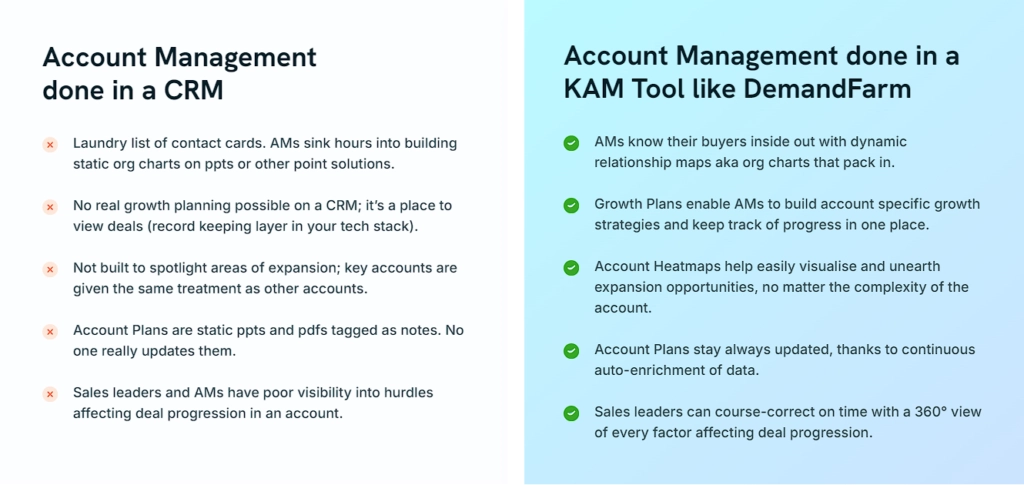Successful key account management today requires smart key account management tools / technology to understand customers deeply, map relationships, and act quickly on opportunities. Unpredicatable global market dynamics, tariff wars, logistics disruption, AI explosion, pandemic, or constantly shifting client priorities are making key account planning harder. Your static slides and org charts go stale even before the rubber meets the road.
Account managers need tools that automatically update plans, surface real-time risks and opportunities, and free them to focus on genuine relationship growth for sustained success in 2026.
What should you look for in Key Account Management Software?
When choosing Key Account Management tools or software, look for solutions that are AI-powered, centralize all account data, automate updates, and provide real-time insights on risks and whitespace opportunities. Strong relationship mapping, AI-driven recommendations, and seamless integration with existing systems help drive strategic growth and collaboration. User-friendly interfaces and customizable dashboards are essential to ensure adoption and efficiency across teams.
The tools listed below take different approaches to Key Account Management, and any of them can be chosen based on the needs of the team using the tool. While some are CRM tools with enhanced functionalities, few are built with KAM as their focus.
List of 8 Key Account Management Tools Every Key Account Manager Needs
1. DemandFarm
DemandFarm is the world’s first agentic AI-powered and CRM-agnostic Key Account Management Software tool for account managers and sales leaders to manage and grow the top 20% of key customers.
What it does
DemandFarm helps thousands of sales leaders and account managers in global enterprises:
– proactively uncover cross-sell & upsell revenue opportunities
– methodically manage deal-critical strategic relationships
– systematize opportunity management.
DemandFarm seamlessly integrates with all popular CRMs, including Hubspot, Dynamics, Zoho, Pipedrive and Salesforce(native), ensuring a smooth transition into the existing workflow.

The need for it
B2B companies use DemandFarm to simplify key account management and make it predictable and scalable. Here are the pain points it addresses:
– Systemize whitespacing through a visual representation of customers’ buying centers vs your offerings
– Prevent the risk of losing important account knowledge and thereby the account itself
– Gain better visibility of your growth/expansion opportunities by pulling in data from multiple apps in one place
– Eliminate blindspots in key account relationships and let account managers spend 100% of their time on the right contacts
– Makes account planning dynamic, proactive & real-time, so that you can track growth & course-correct on the fly
See DemandFarm in Action
2. LinkedIn Sales Navigator
Being the world’s largest professional network, LinkedIn boasts of 700+ million users in more than 200 countries and territories, and LinkedIn Sales Navigator uses this wide reach to keep its users up-to-date with the accounts, while identifying and connecting with important stakeholders and new prospects.
What it does
LinkedIn Sales Navigator provides more than 50 advanced filters to narrow down leads by criteria such as job title, seniority, company size, and recent engagement. Features like Account IQ and Lead IQ leverage AI to surface high-potential leads and relevant account insights. Real-time alerts notify users of job changes, content interactions, and other key signals that help time outreach precisely. Visual tools such as Relationship Maps clarify complex buying groups, while CRM integrations automate data syncing, reducing manual input and errors
The need for it
Being the preeminent social network has its advantages, and Sales Navigator provides more contact data than the limited access of the free version. Sales teams can unlock more people in their search results during prospecting. With buying circles growing and deals moving fast, Sales Navigator simplifies prospecting and helps account managers focus their efforts, ensuring no critical stakeholder or signal is missed in 2026.
3. Salesforce Sales Cloud + Account Plans
Salesforce is a widely used CRM platform for managing comprehensive customer relationships and sales processes. Its Account Plans feature integrates strategic account planning directly into the CRM, aiming to streamline collaboration and organization around key accounts.
What it does
Salesforce Account Plans provide a centralized space to store account strategies, including a built-in SWOT analysis, goal setting with measurable metrics, and visual relationship mapping of stakeholders. The module supports real-time reporting through native dashboards, allowing teams to monitor account health and progress against objectives. Users can create multiple plans per account, customize fields and layouts, and automate workflows for tailored account management processes.
The need for it
While Salesforce Account Plans provide a foundation for organizing account strategies within the CRM, they tend to offer a surface-level approach that fails for managing complex, global key accounts. Limitations include:
– Limited depth in managing complex relationships and nuanced buyer ecosystems
– Lack of advanced KAM features like dynamic whitespace discovery and AI-driven prioritization
– Heavy reliance on manual updates, risking stale or static plans in dynamic markets
– A product roadmap that suggests KAM features receive lower priority within Salesforce’s broader ecosystem
– Usability compromises due to the platform’s heavy customization, which can hinder key account manager productivity
– Fragmented collaboration and insufficient account intelligence for proactive engagement
Consequently, many organizations supplement or replace Salesforce Account Plans with DemandFarm that deliver deeper insights, proactive guidance, and advanced growth management to better handle strategic accounts.
Salesforce Account Plans Explained in Detail
4. OrgChartHub
OrgChartHub is a HubSpot-native tool designed to help account managers build and manage organizational charts directly within their Hubspot CRM. It provides a visual platform to map out complex buying centers, stakeholder roles, and engagement levels, supporting relationship-driven account management.
What it does
The tool offers a drag-and-drop builder for org charts, integrated into HubSpot. Account managers can tag contacts with roles like Decision Maker or Influencer, add placeholder contacts for unknown stakeholders, and view activity heatmaps that visualize engagement across the buying committee. By synchronizing with HubSpot company and contact records, OrgChartHub ensures charts stay current and actionable for prioritizing outreach and uncovering relationship gaps.
The need for it
In complex B2B sales and account management, understanding the structure and influence within target accounts is critical. OrgChartHub provides account managers with a lightweight, focused solution to visualize and manage these relationships without leaving their CRM. However, its manual chart-building approach and limited AI-driven insights mean it may lack scalability and depth compared to specialized AI-powered KAM tools, making it better suited for teams primarily working within HubSpot who need clear, visual stakeholder maps to guide engagement.
5. Zoominfo
ZoomInfo is a B2B contact and company data platform widely used by sales and account management teams to access comprehensive, real-time business information. The platform combines AI, human research, and multiple data sources to maintain a large, accurate database with verified contact details and firmographics.
What it does
ZoomInfo enables account managers to find key decision-makers, buyers, influencers and gather detailed contact information such as verified emails, direct dials, and job titles. Features like advanced filtering and segmentation help users build highly targeted prospect lists. Integrations with Salesforce, HubSpot, and sales engagement platforms allow seamless syncing and enrichment of CRM records, cutting down on manual data entry and keeping customer profiles up to date. The platform’s Chrome extension provides easy access to contact details and account insights while browsing LinkedIn or company websites.
The need for it
In the fast-paced world of B2B sales, having accurate, up-to-date contact data is crucial to efficient outreach and relationship building. ZoomInfo supplies account managers with actionable intelligence on both individuals and companies, helping to prioritize efforts and personalize engagement. Its data enrichment and real-time updates reduce the risk of stale or incomplete CRM data, enabling better pipeline management and conversion rates. For teams aiming to scale outreach while maintaining data quality, ZoomInfo is a valuable tool that addresses a critical foundation of successful account management.
6. Gong
Gong is a revenue intelligence platform that captures and analyzes sales conversations across calls, meetings, and emails. It applies AI and natural language processing to extract actionable insights, enabling sales and account management teams to improve performance and forecast accuracy.
What it does
Gong automatically records and transcribes conversations, then analyzes talk patterns, sentiment, competitive mentions, and key buyer signals. For account managers, this means deep visibility into the nuances of customer interactions without relying solely on manual CRM data entry. Gong highlights engagement trends, identifies opportunity risks, and surfaces coaching moments, helping account teams focus on deals and relationships that matter most. Its integration with CRMs like Salesforce allows these insights to flow seamlessly into existing workflows. Unlike static tools, Gong’s AI continually monitors conversations to detect account health changes, risks, and new upsell or cross-sell opportunities proactively.
The need for it
In key account management, understanding relationship power dynamics, sentiment, and influence is critical. Tools like DemandFarm leverage Gong data to map influences, power, affinity, and sentiment automatically in relationship maps and generate risk alerts for accounts and opportunities, Gong uniquely analyzes the actual conversational data fueling those relationships. This conversation-level intelligence equips account managers to engage more effectively and act on early warning signs of churn or deal shifts. Gong and DemandFarm thus complement each other, Gong providing AI-powered conversation insights while platforms like DemandFarm focus on relationship visualization and strategic account planning.
7. CRMs
Customer Relationship Management (CRM) tools like MS Dynamics, Pipedrive, Zoho, Hubspot or Salesforce are widely used by sales and account mgmt teams to centralize customer data, track interactions, and manage pipelines. They form the backbone of organizations’ sales operations.
What it does
CRMs collect and store detailed account information, log communications, automate workflows, and generate reports. They help teams collaborate by providing visibility into client history and sales activities. For account managers, CRMs offer essential capabilities such as contact management, deal tracking, task automation, and integration with other sales tools.
The need for it
While essential for day-to-day account management, CRMs fall short for strategic key account needs. They typically lack capabilities like dynamic relationship mapping, real-time risk alerts, whitespace identification, and AI-powered guidance. CRMs often focus on transaction-level data and miss the broader, multi-dimensional insights required to grow complex accounts effectively.
Specialized KAM platforms like DemandFarm fill these gaps. They offer richer, proactive insights and tailored workflows that enable account managers to deepen relationships, identify risks early, and drive sustained account growth in areas where traditional CRMs struggle to deliver. This makes relying solely on CRMs limiting for advancing key account programs.

8. AI Assistants
AI GPT tools like Google Gemini, ChatGPT, and Perplexity are advanced language models designed to understand and generate human-like text, offering powerful conversational and research capabilities.
What it does
They assist account managers by providing quick answers, generating content, and synthesizing information from multiple sources. Gemini excels in handling large, multimodal data with deep context retention, ChatGPT offers versatile, creative conversation and content generation, while Perplexity provides fast, fact-based answers with real-time web search integration.
The need for it
Account managers use these tools to speed up research, brainstorm strategies, and enhance communication. However, because these GPTs aren’t directly integrated into sales tech stacks, their responses lack the specialization and real-time relevance needed for key account management. Critical tasks like prioritizing opportunities or identifying key contacts require specialized AI.
DemandFarm’s KAMpanion fills this gap with instant relationship mapping, AI-powered deep research, proactive risk alerts, and strategic growth guidance tailored specifically to key accounts, capabilities that GPT tools alone do not fully provide. This specialist focus is essential for transforming AI insights into actionable account management outcomes.
Words to leave by
Key account management (KAM) is essential for focusing on high-value clients to foster long-term loyalty, increase revenue, and reduce churn. By understanding each client’s unique needs, companies can tailor strategies that maximize growth and retention. However, traditional approaches often lack the automation, insights, and relationship depth needed in today’s complex market environments. Advanced tools like DemandFarm or specialized AI platforms are crucial to overcoming these limitations, providing real-time relationship mapping, proactive risk alerts, and data-driven growth strategies for true strategic partnership.

